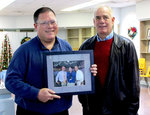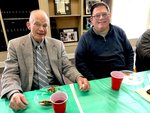A few days ago, I did something I haven’t needed to do for 34½ years. I signed up for a subscription to the Shelbyville Times-Gazette. I’ve never needed a subscription because I was usually here when the presses rolled, and I could grab one right out of the press room if I needed to, while the ink was still warm. ...
This item is available in full to subscribers.
To continue reading, you will need to either log in to your subscriber account, or purchase a new subscription.
If you are a current print subscriber, you can set up a free website account and connect your subscription to it by clicking here.
If you are a digital subscriber with an active, online-only subscription then you already have an account here. Just reset your password if you've not yet logged in to your account on this new site.
Otherwise, click here to view your options for subscribing.
Please log in to continue |




A few days ago, I did something I haven’t needed to do for 34½ years.
I signed up for a subscription to the Shelbyville Times-Gazette.
I’ve never needed a subscription because I was usually here when the presses rolled, and I could grab one right out of the press room if I needed to, while the ink was still warm. Chances are, though, that I’d already seen most of what was in the paper before the presses started running, and I’d written some part of it myself. There was certainly no need for a newspaper on my doorstep or in my mailbox.
Now, though, I’ll be reading the T-G, online and in print, as a customer rather than an employee. I’ve accepted a job with Bedford County government, and Friday, March 6, was my last day in the T-G newsroom.
I was not looking to leave; the county approached me about a job that seemed to fit my abilities, and I agreed it was a good match. Still, it’s scary to give up the place I’ve worked since a year after college.
When I graduated from Oral Roberts University in 1984, I envisioned a career for myself as a screenwriter. A husband and wife who had been two of my professors wanted me to work for their company, so I killed time for a few months at a radio station in Wagoner, Oklahoma, until they were ready for me. Then, I went to Texas to work for my professors. But they never got funding for their first movie project, and so in 1985, after only three months in Texas, I returned home to Bedford County, tail between my legs, and started looking for work.
I had taken a few newspaper classes in college, although it hadn’t been my emphasis, and so I eventually put in an application at the Times-Gazette, which at the time was still owned by Franklin and Johnnie Yates, with Mr. Yates as publisher and his son-in-law David Segroves as associate publisher. Chris Shofner was de facto editor, but hadn’t been given the title officially yet.
Mr. Yates first told me that he didn’t have any openings — which I knew wasn’t true from my prior conversation with Chris. I went away thinking that Mr. Yates just didn’t like me for some reason. But it turns out he just didn’t want to tip his hand until after he’d checked me out. You’d have to have known him. He could be gruff and intimidating, but he had a heart of gold.
He saw on my résumé that I’d gone to Cascade High School, and instead of calling any of the people I’d listed as references he called Marvin Whitaker, who had been my principal there. Mr. Whitaker was also the layleader at Bell Buckle United Methodist Church, where my father was pastor. I’m sure he praised me to Mr. Yates, probably more than I deserved. Mr. Yates called me back a day or two later and offered me a job. I started right after the 4th of July weekend in 1985.
I haven’t been here nearly as long as David Melson or Morris Winfrey, and not as long as Carol Spray or Mary Cook either. But I’ve still been here long enough to see plenty of changes, in technology, ownership, production schedule, and in the community.
Someone asked me the other day about the most memorable story I’d covered during my time at the paper. The one that always sticks in my head was the story of the late Ed Clark, from back within a year or two of me starting at the newspaper in 1985. Today, I am furious whenever I see sources stating that Ed Clark was born in Nashville. He was not. He was born in Raus, in Bedford County, and his family moved to Nashville while he was a toddler. That was a key point of our telephone interview: his family connections to Bedford County. Early in Ed Clark’s career, when he was working for the Nashville Tennessean, he caught a ride to Shelbyville with National Guard troops to cover the burning of the Bedford County courthouse by an angry mob in December 1934.
Ed Clark became one of the greatest photographers for Life magazine in its heyday. His most famous photo was of an African-American playing the accordion in a military band as Franklin D. Roosevelt’s funeral procession passed through downtown Warm Springs, Georgia. Tears stream down the man’s face. The picture came about through serendipity. Clark ran into a drugstore to buy more film, and when he emerged from the drugstore he noticed the military band across the street from him.
Ed Clark also photographed Sen. John F. Kennedy peeping at infant Caroline Kennedy over the edge of her bassinet. He photographed Marilyn Monroe and Jane Russell on the set of “Gentlemen Prefer Blondes.”
He took a portrait of President Dwight D. Eisenhower using one of Matthew Brady’s Civil War-era cameras. He warned Eisenhower that he’d have to hold still for a certain number of seconds, and when it was over, Eisenhower — who’d learned to count seconds accurately during his days in the artillery — corrected Clark on the time.
In the early 1960s, however, Ed Clark lost his vision due to cataracts. He had to give up his photography career.
By the early 1980s, though, cataract surgery allowed Clark to regain his vision and begin taking photos again. When I did my original story on him, he was still living in Maryland, but a few years later, he moved home to Tennessee, where he lived in Nashville and had darkroom privileges at Nashville Tech. He married a woman whom I seem to recall had been his home health nurse, and they had a civil ceremony here in the Bedford County Courthouse. For some reason, I had a conflict and someone else ended up covering the courthouse ceremony.
When our local Wendy’s re-opened after being closed for a year or two, I called the corporate offices and asked for an interview with Wendy’s founder and TV spokesman Dave Thomas. I figured the worst they could do was say “no,” but the corporate spokesman got right back to me and the very next day I was on the phone with Dave. The interview was a little bit too quick, in fact — my autographed copy of Dave’s autobiography didn’t arrive until a day or two later, and it would have been helpful preparation for the interview.
I remember covering the hoopla when the state, promoting a site which would have spanned Bedford and Rutherford counties, was on a short list competing to host the Superconducting Super Collider, an underground particle accelerator which was eventually awarded to Texas (but never actually built). Today, the rural areas of southern Rutherford County and northern Bedford County have seen huge residential growth — it’s interesting to imagine what might have been different if the SSC had been built here.
I remember sitting in the press box for the Tennessee Walking Horse National Celebration the night Bud Dunn and Dark Spirit’s Rebel won the World Grand Championship, and getting a quote from Gov. Ned McWherter after the show. I had come downstairs from the press box into the Celebration offices, and Gov. McWherter was waiting there to be picked up for his ride back to Nashville.
“My horse won,” he told me, succinctly.
I also remember sitting in the press box the year that nobody won the World Grand Championship.
I remember when Bedford County Emergency Medical Services was trying to encourage the placement of automated external defibrillators (AEDs) in public places. I had covered this effort on numerous occasions, and when a local bank made a big donation to place AEDs at all three public high schools, BCEMS’s director at the time told me it wouldn’t have happened without my coverage. That’s the type of moment a journalist lives for.
That EMS director was Chad Graham, by the way, who’s now our county mayor, and starting Monday will be my new boss.
Which brings me to county government. I’ve been covering Bedford County Board of Commissioners since 1985, longer than 17 of the 18 current commissioners have served on the board. (The Rev. John Brown has served on the commission since, I believe, 1982.) They had already selected the site for the 1987 jail just before I started covering county government, but I covered its construction. I had no idea I’d still be around to cover the next new jail.
I’ve had a lot of great co-workers over the years. I don’t know what I would have done over the past year as editor without David Melson, Carol Spray, Mary Cook, Dawn Hankins and Chris Siers. Their support and friendship has meant the world to me. I also owe a lot to our columnists and freelancers and contributors. I’ve worked for a lot of great editors — Mark McGee, Kay Rose, Rene Capley, Sadie Fowler and Terence Corrigan, as well as three who are no longer with us: Chris Shofner, John Philleo and Kent Flanagan. Our general manager, Diandra Womble, has been supportive and great to work with, as was my high school classmate Becky McBee before her. William Mitchell, when he was publisher, trusted me with the title of editor, and I will always be grateful to him for that.
A few years ago, I spent a couple of months filling in at our sister paper in Lewisburg, and Larry Taft, who was GM there at the time, was a great encouragement to me.
Even though I’m leaving daily journalism, I want to stress how important local newspapers are. Don’t believe everything you read about the fate of newspapers. Yes, the economics of the paper have changed, production schedules have changed, and newspapers have to figure out how to pay the bills in an era when some people believe that they have a God-given right to free local news just because the Internet exists. (I’ve been arguing with these people on the Times-Gazette Facebook account for the past year, to no avail.) But there’s still a place for local, small-town newspapers, and there are case studies about the bad things that happen when the newspaper goes away and there’s no one left to shine the light of scrutiny on the school board or the city council or the county commission. Good journalism is an asset to the community, and it’s worth paying for, and that’s why I wanted to be sure and get a subscription to the T-G, so that I can continue to read the great work that my co-workers will do in the weeks, months and years to come.
And it’s possible you’ll see my byline in these pages some time in the future. The community has always responded warmly to my first-person accounts of foreign mission trips, and I’ve already told the newsroom that I plan to submit something after my trip to Uganda this summer, if they have room for it and feel like it’s worth publishing. But for now, I leave behind the sound of the printing press and the flop-sweat of do-or-die deadlines and move on to the next chapter of my life.
Thanks to everyone for your support and kind words over the years.
I’ll close with the words of Dennis Miller: “That’s the news — and I … am … outta here!”
—Starting Monday, John I. Carney will work for Bedford County government. His duties will be split between GIS mapping and posting information to the county’s website and social media.